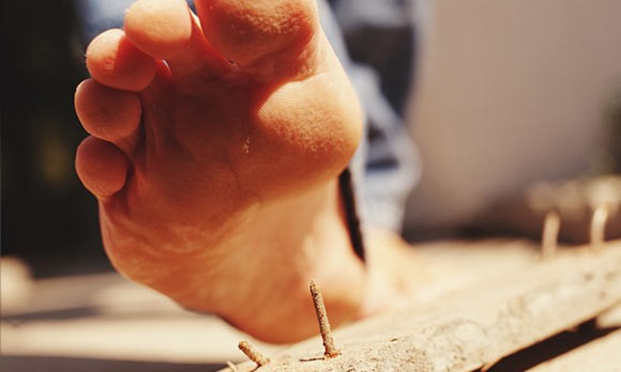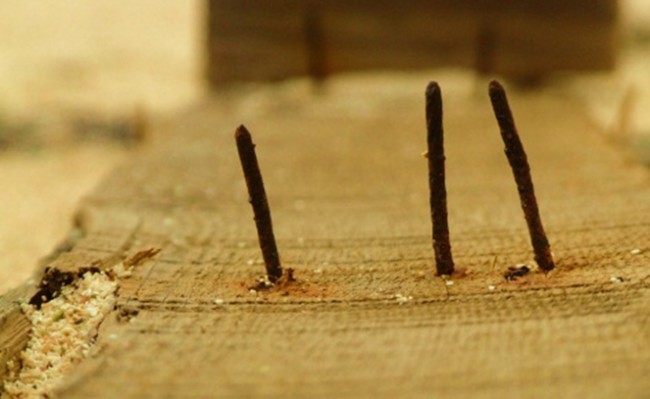The human foot is a marvel of mobility, with 26 bones, 33 joints, 107 ligaments, and 19 muscles and tendons that work together to propel the body forward while supporting its weight. Plantar puncture wounds occur commonly during the summer months when people walk around barefoot and among the people work in the construction industry. One in ten construction workers are injured every year and the highest injury rates in the construction industry are from the ironwork (source: AOL). The complex structure of the foot makes puncture wounds, inherently, increase the risk of infection owing to the fact that the penetrating object (e.g., nails, needles, etc) can implant foreign material deep into the foot.
Puncture wounds that are more distal on the foot, which is where many occur, have a higher risk of infection. Construction sites are the commonest sites where the injury occurs mostly by nails lesser that 50 mm. There is a higher risk of infection if the puncture had occurred at the forefoot, the higher prevalence of infection in forefoot is due to the lack of soft tissue cover and the fact that metatarsals constituted the weight bearing part of the foot which resulted in a greater risk of penetration of bone by the nail.

Symptoms and Health Risks
The symptoms include the pain and swelling. Punctures in the metatarsal- phalangeal joint area may be of higher risk of bone and joint involvement. Osteomyelitis (infection and inflammation of the bone by the contraction of pyogenic bacteria or mycobacteria), cellulitis (bacterial infection involving the inner layers of the skin), soft tissue abscess (collection of puss that has built up within the tissue of the body) and pyarthrosis (bacterial infection in the joint) were known to be associated with plantar puncture injury. Pseudomonas Osteomyelitis resulting from plantar puncture injury was also notorious.
Management of Plantar Puncture injury
Prevention of the injury should be targeted at workers and better education of first aid treatment in the workplace reinforced through proper awareness training programs, regular toolbox talks, mandatory personal protective zone segregation, notice and disciplinary actions and at the workplace through good housekeeping. The initial first aid treatment for plantar puncture injury should be simple wound cleansing followed by dressing with the injured in lying prone with good light and adequate time. The pathophysiology and management of a wound is dependent upon the material that punctured the foot, the location, and the depth, time to presentation, footwear and underlying health status of the victim. The management ranges from wound cleansing for clean and superficial wounds, to surgical debridement for wounds which are high suspiciously of underlying soft tissue infection. Examine the foot for signs of deep injury such as swelling and pain with motion of the toes and test for loss of sensory or motor function. If the puncture was created by a slender object like a needle or tack and the patient is positive that it was removed intact, no further treatment may be necessary.

If there is any question as to whether the object may have broken off in the tissues, obtain x rays. Most metallic and glass foreign bodies are seen on plain radiographs, but plastic, aluminum and wood can be radiolucent and require ultrasound, CT or MRI scans. Incision, irrigation or coring and drainage of the puncture wound would be mandatory if it is deep and complicated. However, local emergency physicians should be consulted to do further suggestions on the antibiotics and other treatment. The plantar puncture wound that has just occurred (‹ 24hours) can be managed expectantly with good anticipatory guidance and return precautions. Empiric coverage for staph and strep should be started if the injury occurred 24-72 hours ago. For the injury occurred more than 72 hours ago, x-rays, bedside ultrasound and empiric coverage for pseudomonas would be appropriate. A steel toe cap boot, which covers the entire length of the toes and steel midsole which protects the foot against penetration by sharp objects and flexible enough to allow the foot to bend is the ideal personal protective equipment against plantar puncture injury.
The best foot forward!
Is from the safe boot onward!
Ananth Tamilmaniarasu
HSE Trainer,
Green World Group,
Dubai
For more Details contact:







Gud one sir